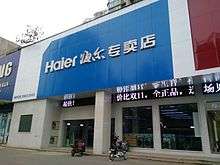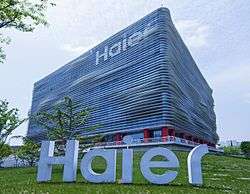Haier
 | |
|
Headquarters in Qingdao, China | |
Native name | 海尔集团 |
|---|---|
| private | |
| Industry |
Home appliances Consumer electronics |
| Founded | 1984 |
| Headquarters | Qingdao, China |
Key people |
Zhang Ruimin (Chairman and CEO) Liang Haishan (Rotating President) Zhou Yunjie (Rotating President) |
| Products |
Major appliances Small appliances Commercial heating and cooling systems Consumer electronics |
| Revenue |
|
Number of employees | 90,000 |
| Subsidiaries |
GE Appliances Fisher & Paykel Haier Electronics Group (SEHK: 1169, OTC Pink: HRELY)) Qingdao Haier (SSE: 600690) |
| Website |
www |
| Haier | |||||||
| Simplified Chinese | 海尔 | ||||||
|---|---|---|---|---|---|---|---|
| Traditional Chinese | 海爾 | ||||||
| |||||||
Haier Group Corporation is a Chinese multinational consumer electronics and home appliances company headquartered in Qingdao, Shandong province, China. It designs, develops, manufactures and sells products including air conditioners, mobile phones, computers, microwave ovens, washing machines, refrigerators, and televisions.
According to data released by Euro monitor, in 2014 the Haier brand had the world's largest market share in white goods, with 10.2 per cent retail volume market share. This was the 6th consecutive year in which Haier had been the market share leader for major appliances.[1]
History
The origins of Haier date back long before the actual founding of the company. In the 1920s, a refrigerator factory was built in Qingdao to supply the Chinese market. After the 1949 establishment of the People's Republic of China, this factory was then taken over and turned into a state-owned enterprise.
Founding

Haier had been founded as Qingdao Refrigerator Co. in 1984. With China opening up to world markets, foreign corporations began searching for partnerships in China. One of these, Germany's refrigerator company Liebherr entered into a joint-venture contract with Qingdao Refrigerator Co., offering technology and equipment to its Chinese counterpart. Refrigerators were to be manufactured under the name of Qingdao-Liebherr (simplified Chinese: 青岛—利勃海尔; traditional Chinese: 青島-利勃海爾; pinyin: Qingdao-Libohaier). The installation of Liebherr's equipment and technology was accompanied by new quality management processes. By 1986, Qingdao Refrigerator had returned to profitability and sales growth averaged 83 percent per year. With sales of just CNY ¥3.5 million in 1984, sales rocketed to CNY ¥40.5 billion by 2000; a growth of more than 11,500 times.[2]
The municipal government asked it to take over some of the city's other ailing appliance makers. In 1988, the company assumed control of Qingdao Electroplating Company (making microwaves) and in 1991 took over Qingdao Air Conditioner Plant and Qingdao Freezer and in 1995, took over Qingdao red star electronics co., LTD, which has been a famous business case included by the Harvard Business School.
Zhang Ruimin and the corporate revival
By the 1980s, the factory had debt of over CNY ¥1.4 million and suffered from dilapidated infrastructure, poor management, and lack of quality controls, resulting from the planned economic system and relevant policies.[3] Production had slowed, rarely surpassing 80 refrigerators a month, and the factory was close to bankruptcy. The Qingdao government hired a young assistant city-manager, Zhang Ruimin, responsible for a number of city-owned appliance companies. Zhang was appointed the managing director of the factory in 1984.
When he arrived in 1984, Zhang decided that improvement was needed to the factory's quality control.
In 1985, a customer brought a faulty refrigerator back to the factory and showed it to Zhang. Zhang and the customer then went through his entire inventory of 400 refrigerators looking for a replacement. In the process he discovered that there was a 20 percent failure rate in his merchandise. To emphasize the importance of product quality, Zhang had the 76 dud refrigerators lined up on the factory floor. He then distributed sledgehammers to the employees and ordered them to destroy the refrigerators. The workers were hesitant; the cost of a refrigerator at the time was about 2 years worth of wages. Seeing their distress, Zhang said: "Destroy them! If we pass these 76 refrigerators for sale, we'll be continuing a mistake that has all but bankrupted our company." The refrigerators were destroyed. One of the hammers used is on display at company headquarters as a reminder to posterity.
Brand
Having diversified its product line beyond refrigerators, the company adopted a new name in 1991. Borrowing from the German name of its partner, "Haier" came from the last two syllables of the Chinese transliteration of Liebherr (pronounced "Li-bo-hai-er"). Qingdao Haier Group was further simplified in 1992 to Haier Group, the company's current name.
In 1995 Haier bought out its chief rival in Qingdao, Red Star Electric Appliance Factory.[4] In 1997, the company moved into television manufacturing with the acquisition of Huangshan Electronics Group.[4] By the end of the 1990s, Haier sold many products including mobile phones and computers, and had the largest national market share in its core white goods division.[4]
International expansion
The company opened a production facility in Indonesia in 1996, and the Philippines and Malaysia in 1997. The company tried to compete in the Thai market, but they completely lost to local electronics companies and had to stop the marketing there. In the US it focused upon two niche markets in compact refrigerators and electric wine cellars.
Haier began to manufacture full-sized refrigerators for North American market. This would bring it into direct competition with established American companies GE, Whirlpool, Frigidaire, and Maytag. As part of its strategy, Haier built a production facility in the United States at Camden, South Carolina, opened in 2000. By 2002, US revenues reached USD $200 million, still small compared to its overall revenue of $7 billion. Also in 2002, Haier moved into a building in midtown Manhattan. Formerly the headquarters for the Greenwich Savings Bank, the 52,000-square-foot (4,800 m2) building was built in 1924 in the neo-classical style.
Production facilities were constructed in Pakistan in 2002 and Jordan in 2003. In Africa, Haier has plants in five countries: Tunisia, Nigeria, Egypt, Algeria and South Africa.[5] The company also purchased a Meneghetti's factory in Italy and began placing its products in European retail chains, either under its own brand or under OEM agreements with foreign partners. Currently Haier has entered into a joint venture agreement with the government of Venezuela.[6]
Haier Appliances (India) P. Ltd initiated its commercial operations in January 2004. Its headquarters is in New Delhi, and in 2015 it had 33 operations, including those in Bombay, Bangladore, Chennai and Calcutta. It was listed among the top 20 most trusted brands in India by The Brand Trust Report, a study conducted by Trust Research Advisory.
In June 2005, Haier made a bid to acquire Maytag Corporation, backed by private equity funds Blackstone Group and Bain Capital. The bid was for USD $1.28 billion, or $16 per share, topping a previous offer of $14.26 per share made by Ripplewood Holdings.[7] In the end however, Maytag was bought by Michigan based Whirlpool Corporation which offered $1.7 billion in cash and stock, or $21 per share, plus assumed debt.[8]

As of 2008, Haier had surpassed rival Whirlpool as the world's top refrigerator producer in terms of sales, according to Euromonitor, an independent business intelligence provider. Haier said it sold 12 million refrigerators worldwide, up 20% over the previous year. Its market share reached 6.3% globally.[9]
In 2012, Haier Group bought the New Zealand appliance manufacturing company Fisher & Paykel.[10]
In January, 2016 Haier Group acquired General Electric's appliance division for $5.4 billion.[11]
Criticism and controversies
In 2014, Haier was accused by German media of delivering smartphones and tablets with pre-installed malware.[12][13][14]
Ownership structure
Although under partial public ownership, Haier is still technically a "collective" company, meaning that it is supposed to be owned by its employees. However, its actual ownership situation is opaque; the employees receive no dividends and do not know how much they own in reality. Interference from officials is also a risk for state-owned enterprises like Haier. Various levels of government often try to push their ailing companies upon successful ones, often resulting in failure; Haier was once talked into acquiring a pharmaceutical company, even though it had no prior experience or infrastructure in biotechnology.[15]
As a government entity, Haier was also officially barred from entering the stock exchange early on. However, the company needed funds for its expansion and therefore sought loopholes to access private equity. In 1993, it listed a subsidiary Qingdao Haier Refrigerator Co. on the Shanghai Stock Exchange, raising CNY ¥370 million. In 2005, Haier entered the Hong Kong Stock Exchange through a "backdoor listing" by acquiring a controlling stake in a publicly listed joint venture Haier-CCT Holdings Ltd. (SEHK: 1169). Haier is also an index stock of the Dow Jones China 88 Index.
See also
- TCL Corporation
- GE Consumer & Industrial
- Siemens AG
- AB Electrolux
- Maytag Corporation
- Samsung Electronics
References
- ↑ Haier Sustains Pole Position in the Euromonitor Global Major at the Wayback Machine (archived August 24, 2015). Bloomberg.com, Jan. 9 2015.
- ↑ "History of Haier Group Corporation – FundingUniverse". Retrieved 15 January 2016.
- ↑ Haier Rises Through Reform and Opening Up
- 1 2 3 Chinese Champions: Patente made in China (PDF; 1,6 MB; German). Technische Universität München, Munich Innovation Group, March 2012, p. 19–23, retrieved September 13, 2013.
- ↑ People's Daily Online - "We will be volunteer 'spokespersons' for Haier," African party officials say
- ↑ Haier's household appliances are sold very well in Venezuela
- ↑ Blackstone and Bain back Chinese firm Haier in $1.28bn Maytag bid
- ↑ Done Deal; Whirlpool Acquires Maytag For $2.7 Billion
- ↑ "Trade Intelligence,Gain valuable business insights from our searchable database of thousands of articles and reports.". Retrieved 15 January 2016.
- ↑ "About Fisher & Paykel". fisherpaykel.com.
- ↑ "China's Haier buying GE appliance unit for $5.4B". USA TODAY. Retrieved 2016-01-15.
- ↑ Benedikt Fuest (10 December 2014). "Vorsicht vor Smartphones mit vorinstallierter Spyware - DIE WELT". DIE WELT. Retrieved 15 January 2016.
- ↑ "Lookout meldet auf Smartphones vorinstallierten Android-Trojaner". ZDNet.de. Retrieved 15 January 2016.
- ↑ IT :: Internet :: Design :: Christian Schmitz. "IT :: Internet :: Design :: Christian Schmitz, News". Retrieved 15 January 2016.
- ↑ Business: A Jack Welch of Communists
External links
| Wikimedia Commons has media related to Haier. |
- Haier official website
- http://admiralwashingmachines.com/haier-washing-machines/
- Haier Group user manuals
- Haier Group official website
